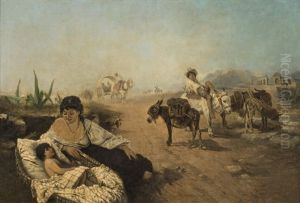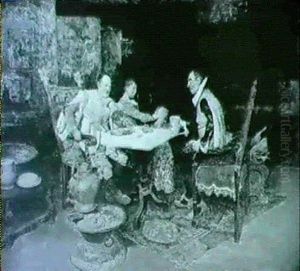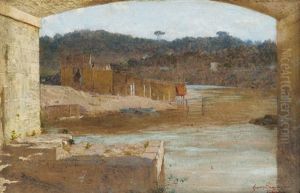Giuseppe Signorini Paintings
Giuseppe Signorini was an Italian artist, recognized for his contributions as a painter and illustrator during the late 19th and early 20th centuries. Born on August 11, 1857, in Rome, Italy, Signorini grew up in an environment rich with artistic heritage, which undoubtedly influenced his career path. He is often associated with the 'Macchiaioli' movement, although he was not directly part of this group of artists. The Macchiaioli were a group of Italian painters active in Tuscany in the second half of the 19th century, who defied the norms of academic painting in Italy by focusing on outdoor light effects and the 'macchia'—Italian for 'patch' or 'spot'—from which the movement derived its name.
Despite the association, Signorini followed his own artistic direction, developing a style that was noted for its realistic portrayal of everyday life, with a particular focus on the working class and the poor. His works often depicted the raw and unembellished aspects of life in Italy, which was a contrast to the idealized and often romanticized images of the country that were popular at the time. Signorini's attention to detail and his ability to capture the emotional depth of his subjects won him recognition among his contemporaries.
Throughout his career, Signorini traveled extensively, which allowed him to study different techniques and approaches to painting. He was particularly influenced by the Realist movement in France and was known to have connections with several French artists. His travels and interactions with artists from different backgrounds enriched his work and contributed to his distinct style.
Giuseppe Signorini's contribution to Italian art is significant not only because of his paintings but also because of his work as an illustrator. He provided illustrations for various publications, which helped disseminate his work to a broader audience. His illustrations often carried the same themes of social realism as his paintings, making powerful statements about the society of his time.
Signorini's work was exhibited in numerous shows and won him several accolades during his lifetime. His legacy is preserved in the collections of various museums across Italy, where his paintings continue to be admired for their historical value and artistic merit. Giuseppe Signorini passed away on April 19, 1932, leaving behind a body of work that provides insight into the social fabric of Italy during a period of significant change.


















